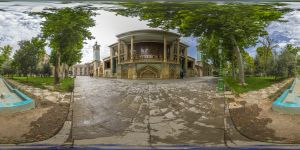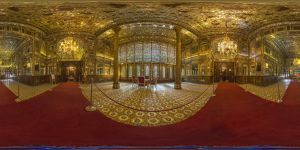More information about Golestan Palace
Golestan Palace - Courtyard

Golestan Palace courtyard, here opposite to the Salam Hall entrance
Emarat Badgir (Building of the Wind Towers) was constructed during the reign of Fath Ali Shah (circa 1806). The building underwent major renovations, including structural changes, during the reign of Nasser-ol-Din Shah. A watercolor rendering by Mahmood Khan Malek-ol-Shoara depicts the original structure prior to renovations,.
The building is flanked by two rooms known as goshvar (earrings). There is a central room which boasts the finest stained glass window in Golestan Palace. Outside, there are four wind towers of blue, yellow and black glazed tiles and a golden cupola. The wind towers are constructed to allow the cooling wind to move through the structure.
The building is flanked by two rooms known as goshvar (earrings). There is a central room which boasts the finest stained glass window in Golestan Palace. Outside, there are four wind towers of blue, yellow and black glazed tiles and a golden cupola. The wind towers are constructed to allow the cooling wind to move through the structure.
Golestan Palace - Wind Catcher Pavilion Exterior

Emarat Badgir (Building of the Wind Towers) was constructed during the reign of Fath Ali Shah (circa 1806). The building underwent major renovations, including structural changes, during the reign of Nasser-ol-Din Shah. A watercolor rendering by Mahmood Khan Malek-ol-Shoara depicts the original structure prior to renovations,.
The building is flanked by two rooms known as goshvar (earrings). There is a central room which boasts the finest stained glass window in Golestan Palace. Outside, there are four wind towers of blue, yellow and black glazed tiles and a golden cupola. The wind towers are constructed to allow the cooling wind to move through the structure.Read more
.....
.....
.....

.jpg)




























